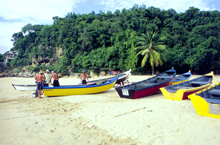The Foundations of Fisheries Science
NOAA is dedicated to the protection of living marine resources through science-based conservation and management and the promotion of healthy ecosystems. As a steward, NOAA conserves, protects, and manages living marine resources in a way that ensures their continuation as functioning components of marine ecosystems, affords economic opportunities, and enhances the quality of life for the American public.

Dutch Harbor and other Alaskan ports are part of the massive North Pacific groundfish industry. Click image for larger view.
Fish and fisheries have always been important to Americans. Fish fed the Native Americans, drew the first Colonists to the continent, and provided one of America's most important industries. All of these activities place increasing demand on fish populations. Early in the history of our country, there was recognition of the importance of balancing these demands with the health of fisheries. Because resource-based decisions are best based on science, the sound management of fish populations has required the evolution of the field of fisheries biology.
This article looks at some of the major scientific advances made by the U.S. Commission of Fish and Fisheries, the predecessor organization to NOAA's National Marine Fisheries Service, from its beginnings in the early 1800s.
Early Foundations
America's concern for fish spawned the earliest conservation laws for the Colonies; these regulations protected aquatic habitat as well as fishing rights. In 1791, Thomas Jefferson, then the U.S. Secretary of State, researched fisheries issues and published the nation's first official fisheries report. Many of the Founding Fathers also wrote about fisheries, including the ever-curious Benjamin Franklin who closely studied marine life.
While international fisheries issues, primarily cod fishing rights, absorbed much of the nation's attention between 1800 and 1850, fisheries protection, restoration, and conservation assumed prominence thereafter.

A concerned fisherman expresses his views at a Regional Fishery Management Council meeting. Click image for larger view.
The first state fish commissions were established in the mid-1850s, to foster restoration of Atlantic salmon and shad. Unchecked pollution from sawmill and tannery wastes were a big problem, but the biggest reason for the decline of salmon and shad was the installation of dams for water power in New England without facilities for passage of fish over them. The first people to raise the issue of the decline were sportsmen, anglers, and hunters. It was these recreational fishermen who moved to establish the first state fish commissions, to press for fish passage facilities and for fish culture to restore decimated populations.
U.S. Commission of Fish and Fisheries is Formed
In 1871, fish research, protection, and restoration became a national issue with the creation of the independent agency, the U.S. Commission of Fish and Fisheries, or just the U.S. Fish Commission (USFC). This agency would eventually evolve into NOAA's National Marine Fisheries Service. Under its founder, Spencer Fullerton Baird, the USFC would help advance fisheries science, conservation, and fish propagation.
Early Initiatives
Baird created an active publishing program that advanced fisheries science knowledge. In company with the Coast Survey, which often loaned vessels to Baird's Fish Commission for research, Baird's publishing program also helped to advance the new science of oceanography. Many of the USFC's early research publications remain foundational fisheries documents today.
One of the USFC's earliest initiatives was the promotion of fish culture. Fish culture involves creating domestic seafood supply to meet seafood demands. While fish culture greatly advanced the cause of fish conservation, marine fish culture was also viewed as the next great step in marine food production. The agency's early fish cultural work was very successful: between 1872 and 1940, 200 billion fish and other aquatic species were distributed and planted in national and international waters.
Baird's initial directive was to study all aspects of the fishes, including their habitat, to try to discern reasons for the perceived decline of marine fishes off New England. He recognized that good habitat and the knowledge of how fishes interacted with their habitats was necessary to properly protect and enhance them. Much of the early USFC research was what would be termed "holistic" today. In recent years, protecting and restoring the nation's fishery resources has once again become a high priority.
Threads between the Past and the Present
Many of the threads pioneered by NOAA's earliest fisheries scientists laid the foundation for modern fish protection and restoration.
A Broad Research Program

Ecosystem management retains flexibility for such small regional fisheries as this dory fleet in Puerto Rico. Click image for larger view.
Baird first initiated ecological research in the 1870s and called for broad-based research into all aspects of the marine environment. He recognized that studying "only the fish" would not be sufficient. Instead, he included studies of fish habitat, feeding, and prey interactions. He combined this information with other observational data such as water temperature and salinity. Baird was well ahead of his time, recognizing the need to integrate physical, biological, and chemical aspects of the environment in studying fisheries. Today, Baird's forward thinking is seen in the National Marine Fisheries Service's move towards ecosystem-based fisheries management, a philosophy that considers all aspects of the marine environment.
Research Centers and Laboratories
The earliest marine research stations and laboratories established in New England by Baird have become modern National Marine Fisheries Service – Fisheries Science Centers. In the early days, these stations conducted fisheries research, just as they do today, to learn about the ranges and migrations of fishes, and their biological characteristics. Today, these centers produce unparalleled peer-reviewed scientific literature upon which sound fishery management is based and which serve as the foundation for future NOAA marine science.

A primary goal of NOAA is to improve recreational fishing data through a national saltwater angler registry. Click image for larger view.
A Statistical Approach
Under Baird, the USFC began collecting fish harvest and trade statistics. Back then, and today, governments collect trade and harvest statistics to determine industry needs, to establish and enforce regulations, and to participate in international negotiations. These statistics also are a source for biological data on breeding rates and population growth or decline. These statistics provide modern fishery managers with sound data used today to create fishery management models.
Research at Sea
Much of the USFC's early research has provided the foundation for modern fisheries science. The agency's first deep-sea research vessel, the Albatross, produced pioneering work in the Pacific Ocean, Atlantic Ocean, and Gulf of Mexico.
The Albatross conducted deep-sea oceanographical research, hydrographic research, fisheries science research, and related science studies, including anthropological and ornithological (bird) research and many others. It even helped chart the course for laying the telegraphic cable from the mainland U.S. to Hawaii.
Almost everything studied aboard the Albatross was pioneering research that laid the foundation for future oceanographic studies; it has been called was the world's most prolific and productive oceanographic research vessel.
Species Protection
In the 1800s, concern for the dwindling numbers of fur seals in Alaska's waters brought greater research, protective measures, and, eventually, an international pact, all of which helped restore seal numbers again to abundance. Likewise, over the years, work on new methods of passing anadromous fishes over dams has been a priority, as has been finding effective means of allowing young fishes to move around dams on their way back out to sea.
The Bureau of Fisheries (formed through a reorganization of the USFC in 1903) also conducted research into fish pathology. In 1915, Congress approved a full-time fish pathologist for the Bureau of Fisheries. Much of the early work in the field dealt with the effects of water pollution on such species as oysters. Identifying those problems allowed oyster growers to find ways to raise oysters in healthier areas.
Focus on Food
The USFC initiated studies of the healthful attributes of a fish diet and the benefits of fish oils. These benefits were studied for decades before their full impact became clear.

The U.S. sea scallop fishery is flourishing as a result of limiting bycatch in bottom-trawling groundfish nets. Click image for larger view.
In 1918, the Bureau won approval for the first fishery products laboratory in Washington, DC. This lab studied more effective ways of smoking, drying, canning, and refrigerating fish. An experimental kitchen was also included, ushering in decades of work on developing new fish recipes and publishing them to promote the consumption of healthful foods. In addition, great progress was made in advancing the freezing of fish, developing fish protein concentrates, surimi production, and other means of adding underutilized species of fish to the nation's food supply.
Safe Fishing Practices
Another thread that runs through the decades is the agency's research into new and better fishing gear. Safer fishing methods and more effective and more selective fishing were, and still are, top priorities. Eventually, much work was done to find ways to harvest fish and still protect endangered species like sea turtles. Other research successfully led to tuna harvest methods that simultaneously protected dolphins from harm.
Conclusion

The modern North Pacific crab fishery reflects substantial changes in management regimes to sustain economic benefits to the region. Click image for larger view.
The importance of living marine resources for food, recreation, and consumer goods spawned early interest in the sound management and restoration of these once vast resources. Management required knowledge of the status of the fish stocks and their behaviors and natural history. This quest for information fueled the evolution of fisheries biology and the scientific principles used to find the answers to these questions.
Today, NOAA continues to conduct fisheries research, to find the answers needed to best manage our nation's marine resources for today and for years to come.
